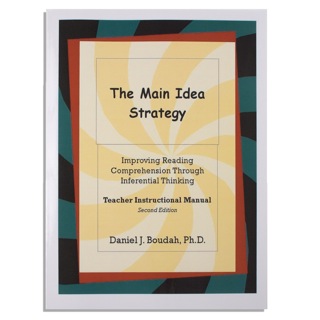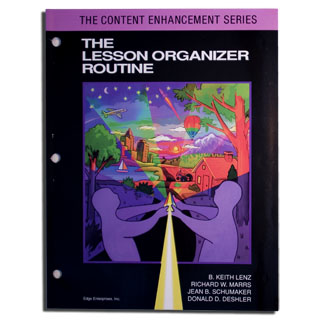Description
Research on Paragraph Writing Strategy Instruction
Studies 1 and 2
Two studies were conducted where seventh through tenth graders learned to use the Paragraph Writing Strategy in conjunction with three paragraph styles: enumerative, sequential, and compare and contrast paragraphs. In the first study, a multiple-probe across-paragraph-styles design was employed with three junior-high students. In the second study, a multiple-probe across-paragraph-styles within a multiple-probe across-students design was used. Five students participated. Instruction was provided by a researcher.
Results
Each time the students wrote a paragraph, the paragraph was awarded points for each type of sentence including topic, detail, and concluding sentences. In Study 1, all three students learned to write organized enumerative paragraphs in the resource room. Their paragraph scores exceeded the 85% level. Also subsequent to strategy instruction, their scores on paragraphs assigned in a general education class improved above the 80% level. However, because the students also immediately generalized their use of the strategy to the other two paragraph styles (and therefore destroyed the experimental control inherent in the multiple-probe across-paragraph-styles design), the second study was conducted with five more students.
Study 2 demonstrated that the students learned to use the paragraph organization strategy for enumerative paragraphs after instruction. All of the students earned more than 85% of the available points on their paragraphs in the resource room. In addition, all of the students generalized their use of the strategy to at least one other paragraph style; three of the students generalized to both additional paragraph styles. After instruction, all of the students met the mastery criterion of earning at least 85% of the points available for paragraph organization on all three paragraph styles. Their mean scores on enumerative paragraphs were 52% in baseline and 92% after instruction; on sequential paragraphs the mean scores were 49% in baseline and 95% after instruction, and on compare-and-contrast paragraphs the mean scores were 38% in baseline and 91% after instruction.
Conclusions
These studies showed that students with LD could learn how to write organized paragraphs given instruction provided in a small-group setting by a researcher. They also showed that students could generalize the structure of paragraphs to different types of paragraphs and to general education settings.
References
Moran, M. R., Schumaker, J. B., & Vetter, A. F. (1981). Teaching a paragraph organization strategy to learning disabled adolescents. (Research Report No. 54). Lawrence, KS: University of Kansas Institute for Research in Learning Disabilities.
Studies 3
Overview
This study focused on the instruction of four writing strategies within a resource room program by the regularly assigned special education teacher. The writing strategies were taught across the course of a full school year. General education English and social studies teachers were recruited to give writing assignments in their classes to provide measures of generalization. Seven participating high school students with LD who had not been enrolled in general education courses in the past were enrolled in these English and social studies classes at the beginning of the school year. The students were first taught the Sentence Writing Strategy (Schumaker & Sheldon, 1985) by their special education teacher in the resource room. Next, the students learned the Paragraph Writing Strategy (Schumaker & Lyerla, 1991). Subsequently, they learned how to detect and correct errors in their writing by learning the Error Monitoring Strategy (Schumaker, Nolan, & Deshler, 1985). Finally, they learned the Theme Writing Strategy (Schumaker, 2003). Throughout the instruction, the students’ writing performance in both the resource room and in targeted general education classes was monitored. That is, every time they wrote a paragraph or an essay in any of the targeted settings, the product was scored for the types of sentences used, the organization of the paragraph, the number of errors, and the organization of the essay. A multiple-probe across-strategies design was employed.
Results
The seven students earned an average of 36% of the points available for a well-planned and organized paragraph during baseline and an average of 80% of the points after instruction on products written in the resource room and in their general education classes. The multiple-baseline across-strategies design demonstrated that each student made gains on pertinent measures only after instruction began for each strategy.
Five of the students made the same kinds of gains on their writing assignments in general education classes as they did in the resource room, even though they had not been taught to use the writing strategies in those settings. The two students who did not generalize their use of the strategies to other classes did so quickly after they had been taught to do so.
Before the study, the students’ GPA was 2.1 in special English and social studies courses designed for low-achieving students and students with disabilities; after the study, their GPA was 2.7 in regular-track general education English and social studies courses.
On a standardized test of writing instruction, the Woodcock Johnson Psychoeducational Battery, the students’ mean grade equivalent score increased by two grade levels from 6.2 to 8.2. On the district’s minimal competency writing exam, the students earned a mean overall score of 3.5 (out of 5.0), which compared favorably to the mean overall district average of 2.5. With regard to maintenance of strategy usage, the four students who returned to the school the following school year and who had learned all the strategies demonstrated that they could write organized paragraphs in their general education classes at mastery levels.
Conclusions
Thus, this study demonstrated that high school students with LD could learn the Paragraph Writing Strategy in a resource room program when instructed by their regularly assigned special education teacher. It also showed that they could generalize their use of the Paragraph Writing Strategy to assignments given in their required general education courses and that they could maintain their use of the strategy across several months. It also showed that strategy instruction was associated with growth in standardized writing test scores and produced favorable writing competency test scores.
References
Schmidt, J. L. (1983). The effects of four generalization conditions on learning disabled adolescents’ written language performance in the regular classroom. Unpublished doctoral dissertation. University of Kansas, Lawrence.
Schmidt, J. L., Deshler, D. D., Schumaker, J. B., & Alley, G. R. (1989). Effects of generalization instruction on the written language performance of adolescents with learning disabilities in the mainstream classroom. Reading, Writing, and Learning Disabilities, 4(4), 291-309.
About the Author

Karen D. Lyerla, M.S.
Affliations
Retired Department Chairperson of Special Services
Lawrence High School
Lawrence, KS
Consultant and Certified Professional Development Specialist
University of Kansas Center for Research on Learning
Lawrence, KS
Project Coordinator
Edge Enterprises, Inc.
Lawrence, KS
My Background and Interests
I am the first woman in my dad’s or mother’s family to receive both bachelor’s and master’s degrees, and I’m deeply proud to represent my Lyerla and Cromer families in this endeavor. I once thought I would like to become a foreign diplomat. Realizing that mastery of a foreign language would be required for this career, I started learning two languages. However, foreign languages and I did not get along. Next, I aspired to become a high school social studies teacher, but my interviewers seemed much more interested in my coaching abilities—which were few and none. Undaunted, I continued to pursue a career in education becoming one of, if not the first, secondary teacher in the master’s program in learning disabilities at the University of Kansas. Dr. Gordon Alley was my deeply treasured advisor and mentor. With his enthusiasm and dedication, he soon injected me wholeheartedly with his educational dreams of a future involving successful young adults with learning disabilities. I never looked back. Even though I have retired after 35 years of teaching at-risk youths, I continue to promote Dr. Alley’s and my dreams for all young adults.
My interests entail a broad spectrum of hobbies and activities. These include a tremendous love of reading, especially trash flash romance and science fiction novels. I also keep up on reading about royalty around the world. I play tennis, swim, and work out with Pilates several times weekly. I adore travel and have been known to bicycle England and Scotland, scooter through Europe, relax in Kauai and Oahu, ski all over the U.S. and Europe, explore the United States, and discover much of Alaska. I love music and dancing. Having chaired my high school’s 40th class reunion, I also helped to cultivate our next class extravaganza, “66ers turn 60” woodsy and our upcoming 45th class reunion. Currently, I support my two great-nieces and my great-nephew in many of their activities at Mill Valley High school, a part of the De Soto School District. Recently. I received my own “Mill Valley Proud Auntie” stadium seat.
The Story Behind the Paragraph Writing Strategy
Writing represents one of my passions. All the nuances involved within the written expression continuum excite me. A well-written composition of any kind offers a sense of rightness in my world. The sound and flow of pencil lead over paper in high school provided me with satisfaction of a job well done. I enjoyed the university ‘blue book’ finals where I became more skilled and adept at speaking my thoughts in written form. Dr. Gordon Alley, my master’s advisor and mentor at KU, and I endlessly discussed and debated the written words within my thesis. Once I began my career as a high school teacher of students with learning disabilities, I realized the importance of the written word for all young men and woman–especially once computers entered our world. Indeed, I experienced major struggles and extreme frustrations as I onerously shifted from pencil and paper into the techno world of Apple Works, Claris Works, MacWrite, and Microsoft Word. I truly understood from this experience what my LD, ED, ADHD, Aspergers’, and at-risk students (the majority reading and writing at about a third- or fourth-grade level) experienced on a daily basis while they fought to stay up with their content classes. As a result, I began a life-long study of written expression. I narrowed my focus and research to paragraphs, recognizing that paragraphs could be broken down into more manageable portions allowing young adults to more easily learn, integrate, and generalize writing basic paragraphs as well as writing different paragraph types.
My Thoughts About Paragraph Writing Strategy Instruction
When used in a variety of settings, at different levels of schooling, and with populations of college-bound and at-risk students and students with disabilities, the Paragraph Writing Strategy lays a solid foundation for more multifaceted written expression strategies. Bottom line–the Paragraph Writing Strategy makes sense. The instruction associated with the strategy promotes consecutive learning following the Sentence Writing Strategy or by itself by teaching how to write basic paragraphs as well as different paragraph types using a series of easily memorized and meaningful formulas evolving into a sequential plan for writing substantial, reliable paragraphs. The strategy exists in a continuum of solid writing strategies with each building to enhance each other and empower students with improved and more complex writing skills.
Teacher and Student Feedback on this Product
Several students confided the same idea to me over the years. Having mastered the Paragraph Writing Strategy, they reported that, when they began the instruction, they already knew the basics of paragraph writing, and their knowledge of the information resided somewhere within their brain’s ballpark. Learning the strategy helped them by organizing their knowledge so that the information was visually available, sequential, and categorized into meaning units of information.
I believe the best feedback I received on the Paragraph Writing Strategy came from a student I recently tutored. As a pre-organizer, I asked him to share with me all the information he knew about paragraphs. He came up with two ideas: a paragraph has a main sentence, and it gives information. Three hours later, after having finished a tutoring session on the strategy, he intently looked at me, threw his hands up in the air and said, “Who knew???!!!”
My Contact Information
Email: karendalely@gmail.com
Phone: 785-841-7263








